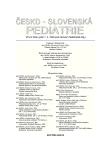Expression Pattern of Homeodomain Genes Does Not Define the Known Subgroups of Childhood Acute Lymphoblastic Leukemias
Authors:
J. Stárková 1; B. Zámostná 2; E. Mejstříková 1; J. Trka 1
Authors‘ workplace:
Klinika dětské hematologie a onkologie, 2. lékařská fakulta, Karlova univerzita, Praha
přednosta prof. MUDr. J. Starý, DrSc.
1; Katedra genetiky a mikrobiologie, Přírodovědecká fakulta, Karlova univerzita, Praha
přednostka prof. RNDr. Z. Palková, CSc.
2
Published in:
Čes-slov Pediat 2010; 65 (9): 497-502.
Category:
Original Papers
Overview
Objective:
The main immunophenotype and genotype subgroups of the childhood acute lymphoblastic leukemias (ALL) have characteristic RNA expression profile. The homeodomain genes (HOX) play an important role in normal hemopoiesis and their role is presumed in pathogenesis of acute leukemias as well. The authors investigated, whether the expression profile of 21 HOX genes of the HOXA, HOXB and CDX group defines selected immunophenotype and genotype groups of children ALL. In comparison with the HOX gene expression in physiological precursors of lymphoid cells we followed whether the expression in malignant cells reflects their relative maturity.
Methods:
HOX gene expression was analyzed by using quantitative RT-PCR in the group of children ALL and normal precursors of lymphoid cells. Analysis of the data was made by the hierarchical clustering analysis.
Results:
In spite of the fact that expression of individual HOX genes differed significantly among individual groups of the children ALL (T-ALL, B precursor ALL with fusion genes TEL/AMLI, BCR/ABL, MLL/AF4 and hyperdiploid one), the total expression profile failed to define the individual subgroups reliably. The comparison of expression of individual HOX genes in the developmental stages of physiological lymphoid cells made it clear that their malignant counterparts express the HOX genes independently of their relative maturity.
Conclusions:
Leukemia cells express aberrantly selected HOX genes. However, the determination of expression profile of HOX genes is not a suitable remedy for classification of childhood leukemia. Highly expressed HOX genes in individual subgroups can potentially serve as targets of biological therapy.
Key words:
childhood acute lymphoblastic leukemia, homeodomain genes
Sources
1. Pui CH, Robison LL, Look AT. Acute lymphoblastic leukaemia. Lancet 2008; 371 : 1030–1043.
2. Yeoh EJ, Ross ME, Shurtleff SA, et al. Classification, subtype discovery, and prediction of outcome in pediatric acute lymphoblastic leukemia by gene expression profiling. Cancer Cell. 2002; 1 : 133–143.
3. Cario G, Stanulla M, Fine BM, et al. Distinct gene expression profiles determine molecular treatment response in childhood acute lymphoblastic leukemia. Blood 2005; 105 : 821–826.
4. Holleman A, den Boer ML, de Menezes RX, et al. The expression of 70 apoptosis genes in relation to lineage, genetic subtype, cellular drug resistance, and outcome in childhood acute lymphoblastic leukemia. Blood 2006; 107 : 769–776.
5. Abramovich C, Humphries RK. Hox regulation of normal and leukemic hematopoietic stem cells. Curr. Opin. Hematol. 2005; 12 : 210–216.
6. Grier DG, Thompson A, Kwasniewska A, et al. The pathophysiology of hox genes and their role in cancer. J. Pathol. 2005; 205 : 154–171.
7. Calvo KR, Sykes DB, Pasillas M, et al. Hoxa9 immortalizes a granulocyte-macrophage colony-stimulating factor-dependent promyelocyte capable of biphenotypic differentiation to neutrophils or macrophages, independent of enforced meis expression. Mol. Cell Biol. 2000; 20 : 3274–3285.
8. Thorsteinsdottir U, Sauvageau G, Hough MR, et al. Overexpression of hoxa10 in murine hematopoietic cells perturbs both myeloid and lymphoid differentiation and leads to acute myeloid leukemia. Mol. Cell Biol. 1997; 17 : 495–505.
9. Drabkin HA, Parsy C, Ferguson K, et al. Quantitative hox expression in chromosomally defined subsets of acute myelogenous leukemia. Leukemia 2002; 16 : 186–195.
10. Andreeff M, Ruvolo V, Gadgil S, et al. Hox expression patterns identify a common signature for favorable AML. Leukemia 2008; 22 : 2041–2047.
Labels
Neonatology Paediatrics General practitioner for children and adolescentsArticle was published in
Czech-Slovak Pediatrics

2010 Issue 9
Most read in this issue
- Congenital Hyperinsulinism – Most Frequent Cause of Persistent Hypoglycemia in Newborns and Infants
- Neonatal Hydrocephalus – The Value of Evaluation of the Brain by Means of Sonography
- The Effect of Initial Management of Ventilation on the Incidence of Bronchopulmonary Dysplasia and Other Morbidities in Neonates Born at 24th–27th Weeks of Gestation at Clinic of Neonatology Slovak University Hospital Nove Zamky
- Expression Pattern of Homeodomain Genes Does Not Define the Known Subgroups of Childhood Acute Lymphoblastic Leukemias
